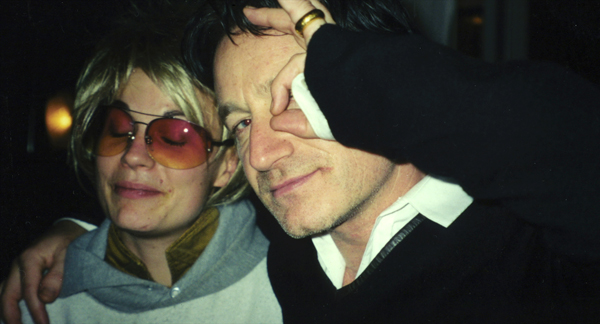![]() JT LeRoy burst onto the literary scene during the mid-to-late 1990s with tough yet vulnerable tales of child abuse and sexual confusion. They were met with critical acclaim and avid interest in the genius behind the prose, which was gradually revealed to be a reclusive young man with androgynous good looks and rumored to be transgender. Packed readings followed, to go with movie star endorsements, inquiries by major filmmakers looking to adapt LeRoy’s work, and growing celebrity status.
JT LeRoy burst onto the literary scene during the mid-to-late 1990s with tough yet vulnerable tales of child abuse and sexual confusion. They were met with critical acclaim and avid interest in the genius behind the prose, which was gradually revealed to be a reclusive young man with androgynous good looks and rumored to be transgender. Packed readings followed, to go with movie star endorsements, inquiries by major filmmakers looking to adapt LeRoy’s work, and growing celebrity status.
But after this triumphant prologue of LeRoy’s background, Author: The JT LeRoy Story shifts to Laura Albert, a middle-aged woman who turns out to be the real writer behind LeRoy. As for the person in all the previous footage, she was no author at all but merely posing as one as part of a plot by Albert, which began to crumble when a journalist found evidence identifying the artist-as-celebrity as Savannah Knoop, the sister of Albert’s boyfriend.
Interviewed in the present day, the real writer offers lots of behind-the-scenes details of this now-notorious literary ruse, and she comes across as personable, if understandably defensive. While it’s easy to dismiss her as a fame-hungry opportunist all along, once her backstory becomes clearer, she proves surprisingly sympathetic.
Born into a broken home with a troubled mother and deadbeat dad, Albert grows up overweight and with a demolished self-esteem, and by her thirties is working as a phone-sex performer. At her absolute nadir, Albert calls a crisis hotline. Convinced she will not garner any sympathy if she presents herself as she is, Albert claims to be a boy named Terminator. Before long, she poses as Terminator for regular phone calls with a therapist, who recommends that she use writing as a means of working out her personal demons, at which point the name becomes the middle initial of Albert’s alter ego, JT LeRoy.
The birth of LeRoy marks the hoax’s starting point, but it grows bigger and more complicated than Albert likely could have foreseen. Yet Author doesn’t move in a straight arrow to chronicle it. While director Jeff Feuerzeig traces LeRoy’s literary evolution and career chronologically, the documentary constantly flashes back to Albert’s past, pointing out how LeRoy was hardly the first avatar she created and that doing so was her way of dealing with the world. For LeRoy, Albert chose Knoop because she seemed the right age and had certain physical qualities that matched her vision of the persona. During LeRoy’s rise to fame, the real author would handle most of her fictional counterpart’s correspondences by phone. However, complications, such as TV interviews, meetings with actors and movie directors, and other opportunities requiring interaction, arose.
Although Albert eventually joins in on the fun as Speedie, ostensibly LeRoy’s British manager, her growing discontent with staying on the sidelines makes this section of the film especially compelling. It also seems surreal. At a trip to Cannes, for example, Albert must watch from a distance as Knoop rubs elbows with the likes of Asia Argento and Bono. Yet she is LeRoy whenever the latter has to talk on the phone, and even Argento (who directed the film adaptation of LeRoy’s novel The Heart Is Deceitful Above All Things) never seems to notice any difference.
Feuerzeig makes the decision to animate select scenes from LeRoy’s writing, underscoring the theme of one’s creation acquiring a life and purpose of its own. Meanwhile, the further Author delves into Albert’s past, the more correlations we see between the real-life author and the fictional one. The dysfunctional mother-child relationship in her novel, Sarah, clearly has some anchor in real life, as Albert’s mother once left her at an amusement park, according to Albert.
There are other revelations as well, some of them quite harrowing, and the film seems to imply it’s hard to tell where Albert ends and LeRoy begins and that such a separation might not even exist. But if it doesn’t then it’s worth asking: Why were we so upset that the fictional work of a male wunderkind turned out to be a middle-aged woman’s instead? Do we value the narratives of certain people more than others? If that’s true, was Albert right to create an avatar such as LeRoy if she wanted her writing to be taken seriously?
To its credit, the film offers hints that its subject might just be every bit as conniving as her detractors would claim—specifically, there’s an extensive collection of audio recordings she made, dating back to a conversation with her first therapist. Why did she feel the need to tape all of these phone calls? Was she urged on by paranoia or the desire to keep trophies as a testament to her skills as a fraudster? Author leaves it up to the viewer to decide for themselves whether Albert is a troubled soul or something more nefarious, but either way this is a fascinating character study and a one-of-a-kind documentary.

















Leave A Comment